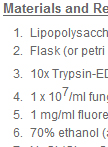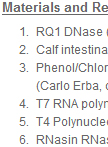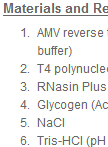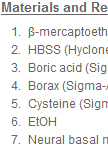Improve Research Reproducibility A Bio-protocol resource
- Protocols
- Articles and Issues
- About
- Become a Reviewer
Past Issue in 2012
Volume: 2, Issue: 14
Biochemistry
Peptide Synthesis
This protocol describes the synthesis of peptides for affinity testing and bioconjugate with solid phase peptide synthesizer at a small scale.
Microbiology
Macrophage Infection by Dimorphic Fungi
Mammalian infection by dimorphic fungi occurs through the inhalation of asexual spores (conidia), which are phagocytosed by host pulmonary alveolar macrophages of the innate immune system. Once phagocytosed, fungal conidia germinate into the pathogenic cell type; unicellular yeast cells which divide by fission (Vanittanakom et al., 2006; Boyce et al., 2011). To investigate if mutation of a particular fungal gene affects macrophage phagocytosis or the production of yeast cells, a murine macrophage cell culture assay can be utilized. This protocol was developed for Penicillium marneffei but is applicable to most dimorphic fungi.
Molecular Biology
Synthesis of 5’ end-labeled RNA
5’ end-labeled RNA molecules are useful substrates to analyse the endo- and exonucleolytic activities of various ribonucleases. Here two protocols are given to synthesize P32 labeled RNAs with a 5’ PPP or 5’ P moiety. 5’ exoribonucleases generally do not work on 5’ PPP RNA and require a 5’ P substrate. The activity of certain endoribonucleases like Escherichia coli (E. coli) RNase E or Bacillus subtilis (B. subtilis) RNase Y can be stimulated by a 5’ P moiety.
Primer Extension Analysis Using AMV Reverse Transcriptase
Primer extension analysis is a useful method to determine the transcription start point or a processing site on an RNA molecule. It can also allow a quantitative measurement of an RNA species.
Neuroscience
In utero Electroporation of Mouse Embryo Brains
This is a non-invasive technique to introduce transgenes into developing brains. In this technique, DNA is injected into the lateral ventricle of the embryonic brains, and is incorporated into the cells through electroporation. Embryos then continue their development in normal conditions in vivo. The effects of genes of interest can be evaluated at certain time points after in utero electroporation. This technique allows acute knockdown or over expression of genes of interest. Compensatory effects from other genes are less likely to happen; it also circumvents possible chronic detrimental effects.
Hippocampal Neuron Dissociation Transfection and Culture in Microfluidics Chambers
Microfluidics chamber is an ideal tool to study local events that occurring in neuronal projections by perfectly compartmentalizing the cell soma from certain branches. It is very well suited for live cell imaging or immunohistochemistry staining. This protocol has been carefully modified in detail to fit the requirement of primary rat hippocampal neuronal cultures. It can also be applied to a more general neuronal culture purpose in microfluidics.
Plant Science
Proteolytic Fragment Isolation and Analysis (ex. N-terminal GST-tagged CLAVATA3 Protein GST-CLV3)
It has become clear that the post-embryonic growth and development of plants requires properly controlled short distance cell-to-cell communication not only through the historically well-known phytohormones, but also through secreted small peptide signals. This protocol demonstrates an example of how to isolate small peptides (< 10 daltons) from complex protein mixtures (e.g. cauliflower meristem protein extraction) for MS/MS analysis.









